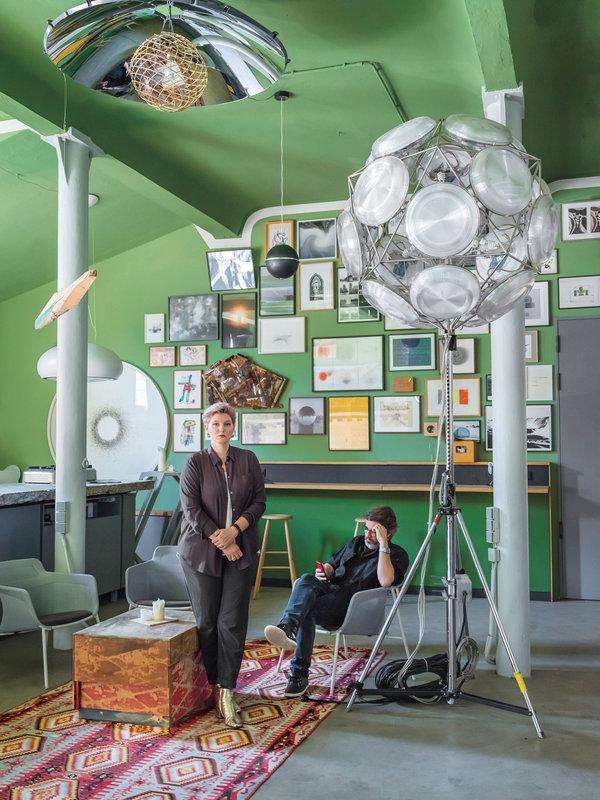Two by Design
Olafur Eliasson and Victoria Eliasdottir, who recently launched the culinary space SOE Kitchen 101 in Reykjavik, view meals as a creative exercise.

Victoria Eliasdottir and Olafur Eliasson in the new event space of Eliasson’s Berlin studio. One of his polyhedral lights rests on a tripod, and on the wall are prints and drawings, some by the siblings’ father.CreditCreditFrank Herfort
By Gisela Williams
When the Icelandic artist Olafur Eliasson was in his early 20s, his father — Elias Hjorleifsson, an aspiring artist who worked as a cook on commercial fishing boats in Iceland — and stepmother had a child, a baby girl they named Victoria Eliasdottir. Eliasson spent most summers with them in Reykjavik, during which he was often relied upon to babysit his new sister. At first, he resented it. “Victoria was quite demanding,” he says with a laugh. “But it was a very bonding experience. I remember it now as a luxury of simplicity. One year, for three to five months, I had two things to achieve: complete my application for art school and prevent my sister from being hungry and crying.”
Eliasson, 51, went on to attend the Royal Danish Academy of Fine Arts and now makes work — at once theoretical and highly accessible — that explores our plastic perceptions of reality and often features mesmerizing bands of colored light. In 2003, he famously installed a shining hemisphere of reflected monofrequency lamps in the Turbine Hall at Tate Modern, under which museumgoers laid out as if sun drunk at the beach. This past June, he inaugurated his first full-scale building, a fortress of bricks and arched windows that appears to rise from the harbor in Vejle, Denmark. The artist travels often, but his primary studio, with four stories and 40,000 square feet, is located in a converted brewery in Berlin’s stylish Prenzlauer Berg neighborhood.

Eliasdottir with members of the studio’s cooking team.CreditFrank Herfort
While Eliasson may be the artist their father dreamed of becoming, Eliasdottir followed more closely in Hjorleifsson’s footsteps. After graduating from culinary school in Reykjavik (as one of three women in her class), she worked under the top Icelandic chefs Steinn Oskar Sigurdsson and Olafur Agustsson and at Alice Waters’s Chez Panisse.
Then, in 2014, she followed her brother to Berlin, where the two collaborated on a one-of-a-kind project. SOE (Studio Olafur Eliasson) Kitchen, which is housed in Eliasson’s studio, is not quite a staff canteen and not quite an art studio; or rather, it’s both and neither. Four times a week, Eliasson’s 120 employees gather at long wooden tables for a vegetarian staff lunch. Here, the meal isn’t about feeding people quickly so they can get back to work but about creating a midday salon. In lieu of dessert, visiting scientists and artists often give talks: the artist Emeka Ogboh on migration, the artist duo Shimurabros on Buddhist cuisine. Once, a high school choir from Copenhagen initiated a rousing singalong of Leonard Cohen’s “Hallelujah.”
A vitrine filled with glass objects, including vintage light bulbs, separates the kitchen from a dining area.CreditFrank Herfort
Following an 18-month stint during which she ran Dottir, her nearby restaurant that served a tasting menu inspired by childhood memories and Scandinavian flavors, Eliasdottir returned to SOE in 2017 to help create a new event series for friends and locals. Vérane Frédiani screened her documentary about women chefs at the studio this past spring, and last October the Canadian chef and food activist Joshna Maharaj spoke on her experiences improving institutional kitchens. Afterward, there was house-made focaccia and herb-infused ratatouille. Just as Eliasson’s art requires the viewer to be an active observer, he and Eliasdottir try to “empower a person to understand that eating isn’t just about passively consuming,” he says.
Last month, the pair launched SOE Kitchen 101, a pop-up culinary space in Reykjavik’s Marshall House, a former fish factory turned arts center where Eliasson maintains a second studio. He’s fashioned polyhedral lights to hang over the restaurant tables where Eliasdottir serves kimchi rice with sesame-marinated cucumbers and roasted eggplant. They’ve partnered with local arts enterprises — i8 Gallery and the event space Mengi — to conceive a series of poetry readings, musical performances and lectures. If all goes well, they’ll open a permanent version of the concept back in Berlin next year. But for now, the siblings are enjoying Iceland together, and the memories it conjures of their father, who died in 2001. “Sometimes I even spot the Helga Maria, a ship he worked on, anchored nearby,” says Eliasdottir. “It’s impossible not to have him hovering around in our minds — I know he’d love that we are working together.”
Olafur Eliasson on How to Do Good Art

Advertisement




